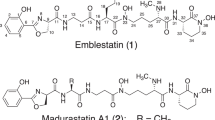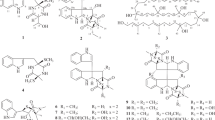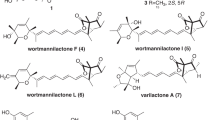Abstract
The marine-derived fungus Trichoderma sp. TPU199 (cf. Trichoderma brevicompactum) produces pretrichodermamide A (1) and gliovirin (2), which possess a rare type of epipolythiodiketopiperazine (ETP) structure with a disulfide bridge between the α- and β-positions of two amino acid residues. We previously reported that this strain gave the halogenated ETPs, DC1149B (4), DC1149R (6), and iododithiobrevamide (7), when fermented with sodium halides (NaCl, NaBr, and NaI). Further analyses of the metabolites obtained under NaI-containing culture conditions resulted in the isolation of two new ETP derivatives (11 and 12) and three new trichothecene sesquiterpenes (13–15). The structures of 11 and 12, including their absolute configurations, were elucidated based on spectroscopic data for 11 and 12 and comparisons with those for 1 and related compounds, revealing that 11 was an epimer of 1 at the C-5 position and 12 was a trithio-derivative of 11. The structures of 13–15 were established by analyzing their 1D and 2D NMR data. The absolute configurations of 13–15 were assigned by comparing their experimental electronic circular dichroism (ECD) spectra with the calculated ECD spectrum of 13.
This is a preview of subscription content, access via your institution
Access options
Subscribe to this journal
Receive 12 print issues and online access
$259.00 per year
only $21.58 per issue
Buy this article
- Purchase on Springer Link
- Instant access to full article PDF
Prices may be subject to local taxes which are calculated during checkout




Similar content being viewed by others
References
Genilloud O. Actinomycetes: still a source of novel antibiotics. Nat Prod Rep. 2017;34:1203–32.
Schueffler A, Anke T. Fungal natural products in research and development. Nat Prod Rep. 2014;31:1425–48.
Omura S. Microbial metabolites: 45 years of wandering, wondering and discovering. Tetrahedron. 2011;67:6420–59.
Butler MS, Blaskovich MA, Cooper MA. Antibiotics in the clinical pipeline at the end of 2015. J Antibiot. 2017;70:3–24.
Butle MS, Robertson AA, Cooper MA. Natural product and natural product derived drugs in clinical trials. Nat Prod Rep. 2014;31:1612–61.
Sanchez JF, Somoza AD, Keller NP, Wang CC. Advances in Aspergillus secondary metabolite research in the post-genomic era. Nat Prod Rep. 2012;29:351–71.
Scherlach K, Hertweck CH. Triggering cryptic natural product biosynthesis in microorganisms. Org Biomol Chem. 2009;7:1753–60.
Zarins-Tutt JS, et al. Prospecting for new bacterial metabolites: a glossary of approaches for inducing, activating and upregulating the biosynthesis of bacterial cryptic or silent natural products. Nat Prod Rep. 2016;33:54–72.
Seephonkai P, Kongsaeree P, Prabpai S, Isaka M, Thebtaranonth Y. Transformation of an irregularly bridged epidithiodiketopiperazine to trichodermamide A. Org Lett. 2006;8:3073–5.
Stipanovic RD, Howell CR. The structure of gliovirin, a new antibiotic from Gliocladium virens. J Antibiot. 1982;35:1326–30.
Stipanovic RD, Howell CR, Hedin PA. Biosynthesis of gliovirin: incorporation of L-phenylalanine (1-13C). J Antibiot. 1994;47:942–4.
Garo E, et al. Trichodermamides A and B, cytotoxic modified dipeptides from the marine-derived fungus Trichoderma virens. J Nat Prod. 2003;66:423–6.
Yamazaki H, Rotinsulu H, Narita R, Takahashi R, Namikoshi M. Induced production of halogenated epidithiodiketopiperazines by a marine-derived Trichoderma cf. brevicompactum with sodium halides. J Nat Prod. 2015;78:2319–21.
Welch TR, Williams RM. Epidithiodioxopiperazines. occurrence, synthesis and biogenesis. Nat Prod Rep. 2014;31:1376–404.
Nakano H, et al. DC1149B, DC1149R and production thereof. Japan: Patent Kokai; 1990: 218686. Accessed 31 Aug 1990.
Yamazaki H, Takahashi O, Murakami K, Namikoshi M. Induced production of a new unprecedented epitrithiodiketopiperazine, chlorotrithiobrevamide, by a culture of the marine-derived Trichoderma cf. brevicompactum with dimethyl sulfoxide. Tetrahedron Lett. 2015;56:6262–5.
Kajula M, et al. Bridged epipolythiodiketopiperazines from Penicillium raciborskii, an endophytic fungus of Rhododendron tomentosum Harmaja. J Nat Prod. 2016;79:685–90.
Zhu M, et al. Penicisulfuranols A–F, alkaloids from the mangrove endophytic fungus Penicillium janthinellum HDN13-309. J Nat Prod. 2017;80:71–5.
Yamazaki H, Rotinsulu H, Takahashi O, Kirikoshi R, Namikoshi M. Induced production of a new dipeptide with a disulfide bridge by long-term fermentation of marine-derived Trichoderma cf. brevicompactum. Tetrahedron Lett. 2016;57:5764–7.
Yurchenko AN, et al. Pretrichodermamides D–F from a marine algicolous fungus Penicillium sp. KMM 4672. Mar Drugs. 2016;14:E122.
Clinical and Laboratory Standards Institute (CLSI). Reference method for broth dilution antifungal susceptibility testing of yeasts. CLSI document M27-A3. 3rd ed. Wayne, PA: Clinical and Laboratory Standards Institute; 2008.
Clinical and Laboratory Standards Institute (CLSI). Reference method for broth dilution antifungal susceptibility testing of filamentous fungi; approved standard CLSI document M38-A2. 3rd ed. Wayne, PA: Clinical and Laboratory Standards Institute; 2008.
Acknowledgements
This work was supported in part by JSPS KAKENHI Grant Numbers 25870660 and 16K21310 to HY, the Takeda Science Foundation to HY, and the Foundation for Japanese Chemical Research to HY. Calculations by Gaussian 09 were performed using supercomputing resources at the Cyberscience Center, Tohoku University. We are grateful to Mr T. Matsuki and S. Sato of Tohoku Medical and Pharmaceutical University for measuring mass spectra.
Author information
Authors and Affiliations
Corresponding author
Ethics declarations
Conflict of interest
The authors declare that they have no conflict of interest.
Additional information
Dedicated to Professor William Fenical in recognition of his contributions to the development of marine natural product chemistry.
Publisher’s note Springer Nature remains neutral with regard to jurisdictional claims in published maps and institutional affiliations.
Supplementary information
Rights and permissions
About this article
Cite this article
Yamazaki, H., Takahashi, O., Kirikoshi, R. et al. Epipolythiodiketopiperazine and trichothecene derivatives from the NaI-containing fermentation of marine-derived Trichoderma cf. brevicompactum. J Antibiot 73, 559–567 (2020). https://doi.org/10.1038/s41429-020-0314-5
Received:
Revised:
Accepted:
Published:
Issue Date:
DOI: https://doi.org/10.1038/s41429-020-0314-5
This article is cited by
-
Contouring Multifaceted Biological Activities and Applications of Trichoderma spp. for Managing Plant Health
Journal of Crop Health (2024)
-
Chemistry and biology of marine-derived Trichoderma metabolites
Natural Products and Bioprospecting (2024)
-
Natural products from marine fungi as a source against agricultural pathogenic fungi
Applied Microbiology and Biotechnology (2023)
-
Exploration of marine natural resources in Indonesia and development of efficient strategies for the production of microbial halogenated metabolites
Journal of Natural Medicines (2022)



